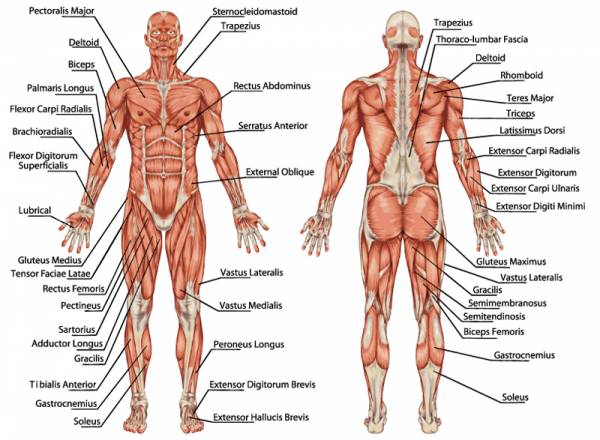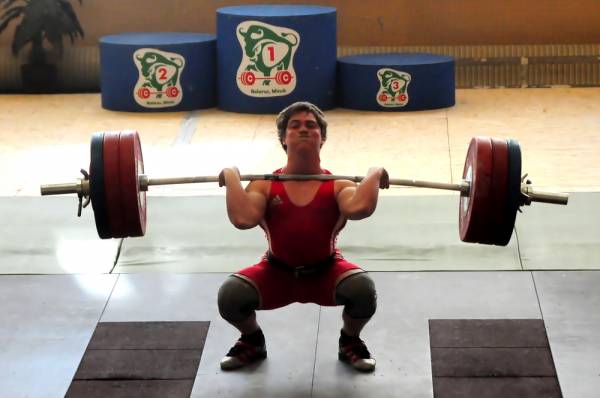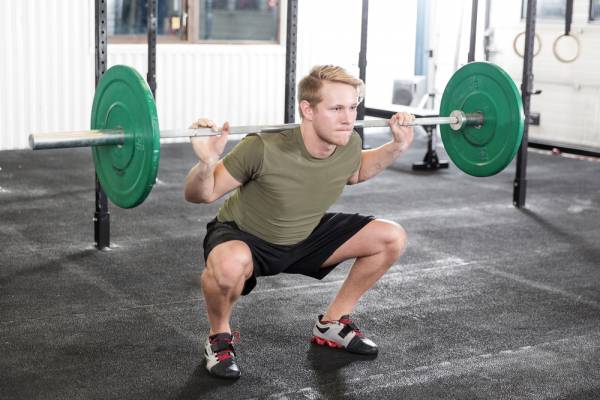Squat with a barbell on your back? Or position it on the front of your shoulders? Which method should you use for the best results? Well, it depends on your training goal, overall joint flexibility, and safety.
Squat with a barbell on your back? Or position it on the front of your shoulders? Which method should you use for the best results? Well, it depends on your training goal, overall joint flexibility, and safety.
Stronger and Larger Legs
Electromyographical studies show both back and front squats recruit many major muscle groups – the upper back, abdominals, lumbar spine, gluteals, thigh adductors, quadriceps, hamstrings, and calves. But the emphasis on these muscles shifts from one lift to the other.

- Front Squats: Emphasize the quadriceps and the upper back. They require a more upright posture, thus minimizing flexion in the lumbar spine and increasing core stabilization to a greater degree of potential spine flexion.
- Back Squats: Focus more on the gluteals and lumbar spine, and are less tedious when performing high-rep, deep fatiguing sets.
“The back or front squat debate. One is not superior to the other. Again, it depends on your training goal, overall joint flexibility, and adherence to safety guidelines.”
Back squats can be performed with heavier resistances, thus many feel this is more effective at stimulating gains in muscle strength and size gains. But other things also factor in, such as set and rep scripts, dietary intake, and genetic potential. So deciding on which squat is not that simple.
Sport Specific Training Is Key
Squatting in general builds stronger muscles that can lead to increases in speed, power, and quickness for sport. Neither the back or front squat is superior to the other because they both engage the aforementioned muscles and emphasize ankle plantar flexion and knee and hip extension.
Both squats make those muscles stronger, but specific sport skills must be practiced to thoroughly enhance them, independent of the mode of squatting used. And naturally, if your sport is powerlifting, you need to back squat. Whereas, an Olympic lifter needs to be adroit at front squatting due to the front-squat component in the clean and jerk.

Joint Flexibility
In general, front squats require appreciably more flexibility than back squats.
The upper back needs to be mobile to keep your chest up. The shoulders and wrists need to be mobile to properly rest the bar. The low back and gluteals need mobility to allow a low enough squat while keeping the knees in line with the toes. Finally, exceptional ankle mobility allows you to keep your feet flat and your lower back from rounding.
“Electromyographical studies show both back and front squats recruit many major muscle groups – the upper back, abdominals, lumbar spine, gluteals, thigh adductors, quadriceps, hamstrings, and calves.”
Back squats require less flexibility in the shoulders, gluteals, and ankles, but that does not mean if you lack flexibility in these joints you can still back squat properly. With either one of these squats, the better your joint flexibility, the better you can execute the movement.
Shoulder Safety
Back squats – either low bar or high bar – place the bar on the upper back or trapezius. This requires the shoulders to be externally rotated and abducted. Having no shoulder joint issues allows you to maintain the bar in this position.
However, an injured shoulder (e.g., rotator cuff or labrum problem) may make it difficult to maintain the bar in that position.
Front squats place the bar on the front of the deltoids. Again, a healthy shoulder can hold this position, but an AC joint separation or shoulder impingement can be irritated by it. The front squat puts the elbows in full flexion and the wrists in full extension.
Any preexisting injuries in either of those joints can be aggravated when front squatting.
If you are someone who is struggling with squatting due to shoulder issues, check out the Top Squat device developed by Dave Draper.
Knee Safety
Both back and front squats can strengthen the knees to reduce the potential for ligament and meniscus tears. To ensure this, the key points are as follows:
- The initial movement should be pushing the butt backward prior to any knee flexion.
- The lower leg remains as close to perpendicular to the ground as possible (knees moving forward minimally).
- Chin up, chest spread, and back flat.
- Heels remain flat during the descent.
“Back squats can be performed with heavier resistances, thus many feel this is more effective at stimulating gains in muscle strength and size gains.”
A big knee stabilizing muscle is the vastus medialis oblique (your inner quadriceps). Front squats target this muscle a bit better than back squats. Front squats also teach you to push your knees out to prevent valgus knee collapse (knee-knock).
Valgus knee collapse is one cause of ACL tearing. Back squats with a wider stance place more load on the gluteals and thigh adductors (groin) and also lessen valgus knee collapse.
Lumbar Spine Safety
Low back strengthening can be accomplished by using proper squatting form, regardless of whether you’re doing a back or front squat.
On the surface, front squats are safer than the back squat due to less excessive forward leaning. However, this does not mean back squatting is more dangerous to the lumbar spine. If the back squat is performed with good technique and appropriate weights, it can be safe.

For those of you with long femur bones and a short torso, your structure can make it difficult to achieve a parallel squat position in either squat variation.
To get down into a full squat, you will have more forward lean, but you can still squat safely if you adhere to the aforesaid technique recommendations discussed in knee safety (e.g., chin up, chest spread, buttocks pushed backward).
Which Squat Is Best for You?
The back or front squat debate. One is not superior to the other. Again, it depends on your training goal, overall joint flexibility, and adherence to safety guidelines.






